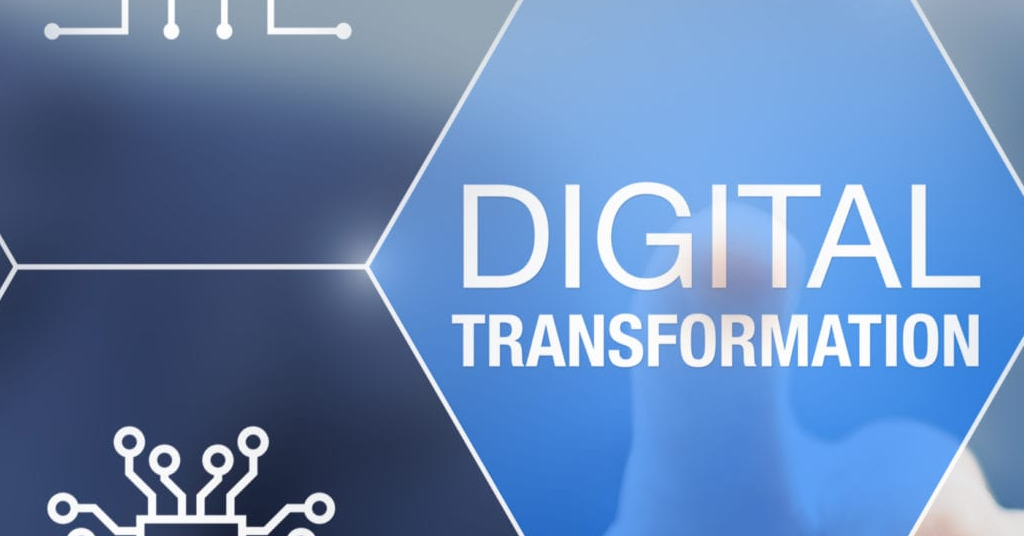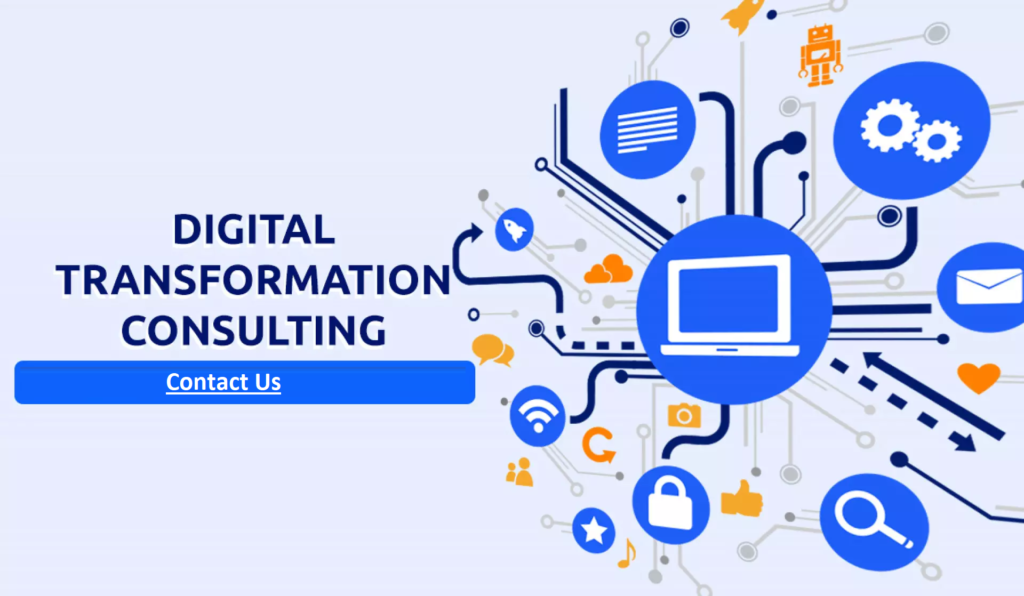Integration of digital technology in different areas of a business, changing the basics of operation and delivery to provide more value to the consumer, is called digital transformation. It is a shifting of the organization’s work culture. Digital Transformation challenges the establishment of the company, thrust into new experiments, accepts failures, and contemplates growth. It uses digital technologies to compete with the changing market and sustain itself. It operates by creating new or modifying existing business processes, environments, and customer experiences. The reimagining of business in the digital age is known as digital transformation.
Digital transformation, on the other hand, begins and ends with how you perceive and interact with customers. It encompasses more than traditional sales, marketing, and customer service roles. With digital technology on our site, we have the opportunity to reimagine how we do business — how we engage with our customers — as we transition from paper to spreadsheets to innovative business management applications.
Importance of Digital Transformation
Digital transformation is critical for all businesses, large and small. That message is loud and clear that the relevancy and competitiveness of the companies can be maintained through digital transformation. There are many articles, discussions, studies, and keynotes on the importance of digital transformation. New business setups which are small tend to start their business first and then transform it when they are making progress. You can predict your company’s future from the beginning. It is simply not possible to run a 21st-century business on sticky notes and handwritten ledgers. Digital thinking, planning, and construction positions you to be agile, adaptable, and ready to grow. With the acceptance of digital transformation worldwide, many businesses are now assessing their business models to find out whether they are on the right path or not.
Why Digital Transformation?
A company may decide to go digital for a variety of reasons. However, the most likely reason is that they must: It’s a matter of life and death. Following the pandemic, the organizations are expected to adapt to the newer market norms quickly, and unaffected by market pressure, disruption of the supply chain and rapid change in customer demands has become critical. Spending priorities reflect this reality. Digital transformation solves the most crucial problem of the company, i.e., keeping in line with the upgrading demand of the consumer and being able to survive for the future. Technological advancements support businesses and provide effective competitiveness in a constantly changing economic environment.
Digital Transformation Solutions
They are all the services you can purchase to help you move your business online. Digital transformation services experts can assist with everything from gathering data about business processes to implementing chosen technology. These digital services can be divided into three main parts:
• Digital Transformation Consulting
Digital Transformation Consulting is a service that simplifies the process of digitalization by taking a different approach to designing. The goal of digital consulting is to improve experience design, customer experience, and marketing transformation by leveraging emerging technologies. While entrusting decisions about your organization to outside experts may appear counterintuitive, a fresh look at business processes can reveal hidden potential and help see new possibilities. Transformation consultants have extensive knowledge of the industry, the typical customer journey, and market dynamics. Combining their domain expertise with insights from leaders and teams can create an effective transformation strategy with measurable business outcomes.
A business strategist and adviser, a digital consultant, is. Digital consultants who work for themselves work with diverse clients. They help companies develop and implement marketing, public relations, web development, branding, and other digital strategies. However, consulting services do not have to end there. Some providers offer all-inclusive digital transformation solutions, taking care of every aspect of the process.
• Digital Transformation Strategy and Framework
COVID-19 has undoubtedly accelerated the adoption of digital transformation services and technologies across a wide range of industries, if not all. In fact, according to IoT Development, the pandemic has accelerated this by 5.3 years in the last year alone. This growth is not easy to achieve in the real world if there is no digital transformation strategy within a workable time for a specific business.
A digital transformation strategy is essentially a plan of action outlining how a business can thrive in the digital age. Because of changing consumer habits, increased efficiency, and other factors, companies must use technology to remain competitive in their industry. Everything is moving to the digital world. As a result, businesses worldwide must keep up with the rapid adoption of technology in all aspects of life.
Form a formidable strategy
Different industries will have different ideas about what a digital transformation strategy entails and what it entails. On the other hand, a digital transformation strategy necessitates using technology to transform an organization into something more valuable to the consumer and more structured for everyone. Developing a digital transformation strategy is the first step toward a genuine revolution. This document considers business processes and aligns them with technology, business needs, and customer expectations. It researches the technological landscape to find the most appropriate solutions for the company’s expectations and budget.
On the other hand, a strategy requires that the people in a company be on board with these transformations. It means utilizing the technology at their disposal and developing innovative plans. Experts working on Digital Transformation Strategy mainly analyze three points:
Status of Current Technology
Transformation consultants investigate all of the current technology in use. They research existing solutions, paying close attention to usability and effectiveness. They take into account the software used by your clients and collaborators. Compatibility is critical.
Requirements of the Businesses
When it comes to digital transformation, organizations have varying expectations. The consultant’s responsibility is to introduce innovation while running day-to-day operations smoothly. After gathering data about the technology in use and insights about the expected outcome, it’s time to draught the plan. Transformation services should be tailored to the needs and capabilities of the client. A bespoke custom-built system will outperform even the best out-of-the-box solution. In some cases, however, both approaches can be combined to provide the best experience at a competitive price.
Capabilities of IT experts of the company
There is one more consideration to make during the digital transformation. After all new systems have been constructed, they must be maintained. HR issues should be considered during the transformation roadmap preparation phase to avoid unpleasant surprises during the implementation phase.
Digital Transformation Implementation
When the strategy is put into action, it is called digital transformation. Ineffective digital transformation services exist only on paper. Yes, planning is essential, but getting past the brainstorming stage can improve the client and team experience. It is critical to remember that some assumptions made during the planning phase may be invalidated during the development phase. IT executives must rely on their expertise to recommend the best solutions, even if it means deviating from the original plan. After all, digital transformation is all about experimenting and being adaptable.
IT market is greatly influenced by digital transformation services, which include:
Application Modernization
The industry is evolving rapidly in response to changing consumer behavior. As a result, companies are implementing new operating and infrastructure models to fill gaps and prepare their IT for emerging market demands. At this point, one critical aspect that is a perfect fit and holds significant importance in the industry’s transformation journey is ‘Application Modernization.’ Application modernization is the most crucial demand due to the growing need for advanced applications to meet the ever-changing requirements. The most common issues with legacy applications make a strong case for enterprise application modernization. The transformation of legacy applications to drive agility and efficiency through modern IT is at the heart of Application Modernization Services. Ideally, these services should reduce the unnecessary costs and maintenance burden that legacy or obsolete applications impose on the organization.
Business Restructuring
All industries’ most common issue is a misalignment of technology and core business processes. Traditional infrastructure poses a significant challenge to firms as a combination of critical hardware, maintenance burden, and high ownership costs, resulting in inflexibility within internal processes. businesses must modernize/upgrade their infrastructure To meet the burgeoning demands of the market. ‘Business Restructuring’ is critical at this point, assisting firms in upgrading and making their business processes and critical infrastructure more responsive than before!
Developing Digital Strategy
Moving to digital is currently the most popular trend, and the race for early digital transformation has already begun. However, it does not come easily because Digital Transformation necessitates meticulous planning and strategy. Begin by creating an effective digital system that will enable you to transform quickly. The first step is to develop a vision, which includes deciding on an image for carrying out the digital transformation process. Instead of limiting yourself to existing capabilities and innovations, focus on the end goal. Then, examine the market trend, as it is critical to comprehend market dynamics before proceeding with any implementation.
Digital Applications
The digital revolution has made technology more accessible than ever before through intelligent devices. And ‘Digital Applications’ is the driving force behind it all! The applications emerged as key growth drivers to achieve rapid market penetration, improved service quality, faster service delivery and increased productivity. As a result, an application-centric transformation has emerged as a critical component of the digital future! Digital transformation necessitates changes to an organization’s operating infrastructure, applications, and assets. One crucial factor in the process is the implementation of digital practices throughout the application lifecycle.
Enhanced User Experience
Customer satisfaction is the bedrock upon which Digital Transformation is built! The secret to digital trends is their ability to provide users with a ‘never-before product experience. It eventually becomes a focal point within organizations throughout all product lifecycle stages. It was expanded further to delivery and customer service, making ‘Enhanced User Experience (UX)’ an essential aspect of digital transformation service offerings. It changes the way people interact with products and services. It visualizes user journeys and behavioral patterns across platforms. Engaging UX connects the customer to the ongoing development of products and services and improves the Information Architecture.
IT Modernization
In any industry, modernization is critical. In IT, on the other hand, modernization is the key to success! While infrastructure modernization is at the heart of any organizational development, developing a digital strategy is equally important in a successful digital transformation journey. Attempting to modernize critical IT systems, on the other hand, is a process that must be approached with caution, as any inconsistency can lead to complex problems. Businesses can begin by taking a comprehensive approach to establishing a link between digital capabilities and existing enterprise infrastructure designed to be updated regularly. Cloud service deployment and multilayered architectures are also viable options.
Benefits of IT modernization
Simplified Architecture
Simplified Architecture Seamless Flow
Seamless Flow Increased Agility
Increased Agility Improved Culture
Improved Culture Effective Resource Usage
Practical Resource Usage Operational Efficiency
Operational Efficiency High Value Delivered
High Value Delivered Quality of Service
Quality of Service
Role of RPA in Digital Transformation
RPA, or robotic process automation, has virtually infinite applications. RPA, at its core, uses software robots, chatbots, artificial intelligence, and machine learning to automate repetitive tasks and streamline workflows across business functions and industries.
These digital technology use cases can vary significantly across industries and are dependent on how software developers implement them.
Reduce human errors
Order processing, data migration, data audits, and invoicing are examples of common RPA silo use cases. There is a distinct possibility of human error in each of these examples.
Human error can cost businesses time, money, and resources, whether an analyst type in the wrong email address or phone number or a data center representative accidentally disrupts one of your algorithms.
Digitalization
RPA is one of the technologies best suited to assisting all organizational functions in their digital transformation. Organizations can address extensive operational challenges, such as executing large amounts of back-office work, thanks to RPA’s capabilities.
Consultancy services based on this technology can assist developer teams, and business users deal with changing digital transformation requirements and internal process changes.
RPA can impact nearly every industry and function, from data protection to low-code application development and deployment. RPA also encourages better team collaboration, which is essential when dealing with operational challenges.
Furthermore, by leveraging RPA’s Big Data analytical capabilities, organizations can learn more about their business patterns and workflow performance. Companies can then use this data to develop digital strategies to improve the efficiency of their processes.
The future of RPA
Though it is difficult to predict where technology will take us next, it is reasonable to expect RPA consultancy services to continue influencing and impacting digital and IoT transformation for the foreseeable future.
RPA software robots are trained to mimic employees’ actions, from simple clicks and copy-and-paste tasks to more complex activities such as bank reconciliations.
RPA can interact with various systems, including ERP, legacy, and other external systems. By performing tasks in the same way, a human employee would, allowing implementation to take weeks, if not days, rather than months.
Digitally Transformed Data Science
In today’s fast-paced competitive world, digital transformation has evolved into a remarkable technology. Several companies have started their transformational journey by implementing digital transformation in novel business models, processes, and technologies; even progressive organizations are seeing the power of digital transformation through their drives around powerful innovations.
Data science offers a unique perspective for all types of businesses, allowing them to create models that further define trends and use them as the foundation for transformative software, such as locating IoT devices and predictive analytics.
When many businesses are looking to unlock the power of business data that lacks the required proficiency and support, the market for Data Science consultancy services is expanding at breakneck speed. It is critical in assisting with the digital transformation of your business.
Contribution of ML, AI, and IoT to Digital Transformation
A perfect storm of technologies, including SaaS, Mobile, Robotics, IoT (Internet of Things), Virtual Reality (VR), and others, is critical to companies’ Digital Transformation (DX).
Artificial Intelligence (AI) and Machine Learning (ML) are the cutting-edge technologies guiding businesses through the challenging task of the Digital Transformation process. Artificial intelligence (AI) is evident as a critical enabler of digital transformation in various industries.
For meeting the changing needs of customers and the market, the transformation process aims to use digital technologies to create or modify customer experiences, culture, and business processes. It is where artificial intelligence development company enters the picture.
It has the potential to help businesses become more innovative, flexible, and adaptable than they have been in the past. Artificial intelligence is one of the most critical digital transformation drivers due to its promise of speed, ease, and cost optimization while simplifying complex processes and systems.
Thinking about Artificial Intelligence (AI) may conjure up images of a futuristic world akin to those depicted in science fiction films. Still, the lines between reality and fiction are becoming increasingly blurred.
How AI is transforming day-to-day life
AI is transforming the world and people’s lives, and it is quickly becoming the driving force behind economic and organizational growth. You may already be interacting with AI/ML-driven tools in many of your daily activities.
Whether it’s a simple Google Search, a conversation with Amazon Alexa, Google Home, or Apple’s Siri, or a simple Chatbot on a website you visited! Without a doubt, this is changing the way we go about our daily lives, organize our work, conduct business, and make decisions.
Business Applications
AI and machine learning (ML) are tools for planning and implementing a digital transformation that focuses on the needs to gain a competitive advantage with customers now and in the future.
They help businesses develop comprehensive data transformation strategies based on real-time market intelligence rather than piecemeal tactics of the disparate system and process updates.
Machine learning analyses and correlates patterns in large amounts of data to provide insights into customer behavior and other events. It provides suggestions for how to improve business processes and customer experiences. Rather than discovering a shift in customer behavior after decline in sales, machine learning assists in identifying changes in behavior and events as they occur, to devise solutions to avoid the decline.
AI uses Algorithms to create or modify programs that use machine learning insights. Artificial intelligence (AI) mimics human intelligence to recognize and respond to behavior and events.
Digital Transformation
Machine learning insights into behavior and events can improve customer experiences and business processes. Using AI and machine learning to plan and implement a digital transformation allows businesses and organizations to stay ahead of the competition.
AI and ML analyze data in realtime. This improves responsiveness to changes in customer behavior and events and improves the efficiency of business processes, including IT operations.
The Internet of Things (IoT) Development serves as a conduit for data-driven, intelligent data transformation. The Internet of Things (IoT) is a network of objects that contain software, sensors, smart devices, and other instruments that allow them to communicate with and exchange data with other systems and devices over the internet.
It acts as a data collection channel for AI and ML and interacts with customers via “things” in IoT to improve experiences and processes. The internet and everything it connects enables digital transformation to take place.
Wrap up
Advances in computing technology and software and access to large amounts of data (thanks to the Internet and SaaS/Cloud-based systems) have enabled the resurgence of AI in the last ten years.
Hardware and software are becoming more powerful, less expensive, and more accessible. It allows the processing of large datasets in a timely and cost-effective manner.
The amount of data generated now will double every two years for the next decade. All of these advancements and other developments in AI have led us to create something extraordinary to help humans.




